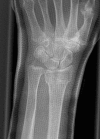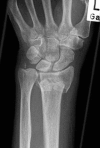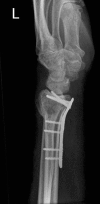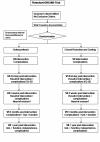Open reduction and internal fixation versus casting for highly comminuted and intra-articular fractures of the distal radius (ORCHID): protocol for a randomized clinical multi-center trial
- PMID: 21426543
- PMCID: PMC3072922
- DOI: 10.1186/1745-6215-12-84
Open reduction and internal fixation versus casting for highly comminuted and intra-articular fractures of the distal radius (ORCHID): protocol for a randomized clinical multi-center trial
Abstract
Background: Fractures of the distal radius represent the most common fracture in elderly patients, and often indicate the onset of symptomatic osteoporosis. A variety of treatment options is available, including closed reduction and plaster casting, K-wire-stabilization, external fixation and open reduction and internal fixation (ORIF) with volar locked plating. The latter is widely promoted by clinicians and hardware manufacturers. Closed reduction and cast stabilization for six weeks is a simple, convenient, and ubiquitously available intervention. In contrast, ORIF requires hospitalization, but allows for functional rehabilitation.Given the lack of randomized controlled trials, it remains unclear whether ORIF leads to better functional outcomes one year after injury than closed reduction and casting.
Methods/design: ORCHID (Open reduction and internal fixation versus casting for highly comminuted intra-articular fractures of the distal radius) is a pragmatic, randomized, multi-center, clinical trial with two parallel treatment arms. It is planned to include 504 patients in 15 participating centers throughout Germany over a three-year period. Patients are allocated by a central web-based randomization tool.The primary objective is to determine differences in the Short Form 36 (SF-36) Physical Component Score (PCS) between volar locked plating and closed reduction and casting of intraarticular, comminuted distal radius fractures in patients > 65 years of age one year after the fracture. Secondary outcomes include differences in other SF-36 dimensions, the EuroQol-5D questionnaire, the Disability of the Arm, Shoulder, and Hand (DASH) instrument. Also, the range of motion in the affected wrist, activities of daily living, complications (including secondary ORIF and revision surgery), as well as serious adverse events will be assessed. Data obtained during the trial will be used for later health-economic evaluations. The trial architecture involves a central statistical unit, an independent monitoring institute, and a data safety monitoring board. Following approval by the institutional review boards of all participating centers, conduct and reporting will strictly adhere to national and international rules, regulations, and recommendations (e.g., Good Clinical Practice, data safety laws, and EQUATOR/CONSORT proposals).
Discussion: To our knowledge, ORCHID is the first multicenter RCT designed to assess quality of life and functional outcomes following operative treatment compared to conservative treatment of complex, intra-articular fractures of the distal radius in elderly patients. The results are expected to influence future treatment recommendations and policies on an international level.
Trial registration: ISRCTN: ISRCTN76120052 Registration date: 31.07.2008; Randomization of first patient: 15.09.2008.
Figures







References
Publication types
MeSH terms
Associated data
LinkOut - more resources
Full Text Sources
Medical
Miscellaneous

